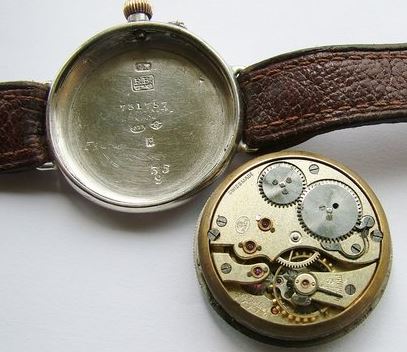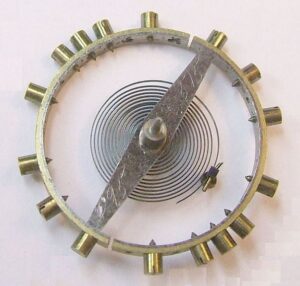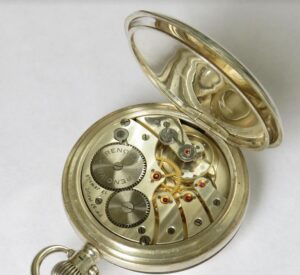Last updated on May 31, 2024
A service is needed to clean and re-lubricate the movement. This will ensure the timekeeping is within normal tolerances and prevent the oils from drying, which can potentially damage the movement. If movement parts become damaged, you may notice the watch loses or gains time, or ultimately completely stops, something which is often seen with antique watches that are well overdue for a service. In this post, we will discuss the process a watchmaker will follow when conducting a service on an antique watch.
How a mechanical watch works
The basic architecture of almost every mechanical watch has changed little in the past three hundred years, which proves what a truly ingenious and efficient machine it is. A mechanical timepiece differs from a modern quartz watch in that it does not rely on a battery as its power source. Instead, a mechanical watch gets its power from the gradual release of energy stored in the tightly coiled mainspring. This slow release of energy powers the watch’s various features, including the movement of the hands around the dial, and any additional complications such as a date function, moon phase, or chronograph.
If left unchecked, the mainspring would quickly unwind and release its energy in a matter of seconds. To prevent this sudden release of power, the barrel that houses the mainspring meshes with the gear train that ends in a mechanism known as the escapement. The escapement consists of a rotating wheel that is caught and released intermittently by a pivoting lever. The pivoting of the lever is controlled by the balance, which is driven by the hairspring. This so-called “lever escapement” controls the energy released from the mainspring. This feeds the power back through the gear train, driving the hands of the watch to count out seconds, minutes and hours.
The balance
The balance and hairspring are the timekeeping components of every mechanical watch. If you have opened the case back of a mechanical watch and seen the movement running, you would have noted that the balance beats and forth at a steady rate many times a second. Overall, this equates somewhere between 18,000 and 36,000 beats per hour. The accuracy of the watch depends largely on the consistency of these beats per hour. This is controlled by the tension of the hairspring, as well as its resistance to temperature changes and magnetism.
Although the mainspring releases power very slowly, the mechanism increases in speed the further down the gear train you travel. Ultimately, the balance wheel is beating over 500,000 times a day. This creates a lot of friction that causes wear and tear on the interlocking components. A lot of this friction is mitigated through the use of jewels, which are hard-wearing low-friction bearings. Lubrication of the moving parts also reduces friction. However, over time the lubricants dry out and lose effectiveness. Dust can enter the movement and, combined with the thickening lubricants, can form an abrasive paste that damages the components. Damage to the movement and the increased friction due to the lack of lubrication can cause the watch to become inaccurate. Regular servicing where the components are completely disassembled, cleaned and relubricated help can prevent this loss of timekeeping.
Servicing an antique watch
An antique watch service should only be attempted by a certified watchmaker. Always discuss the cost of servicing before starting a project. If a watch is broken and parts need to be replaced, it can affect the cost considerably.
British Horological Institute – Accredited Repairers for antique watch servicing.
Disassembly
The watchmaker carefully takes apart the watch, removing the case back, crystal, hands, and movement. The movement will then be stripped down to its individual components. A typical antique pocket watch movement can contain anywhere from 100 to 300 components or more, depending on the complexity of the movement and any additional complications such as a calendar or chronograph function.
Cleaning
After assessment for wear and damage, the watch components are then placed in an ultrasonic cleaning machine, which uses high-frequency sound waves to agitate a cleaning solution. The composition of the cleaning solution can vary depending on the brand, but it typically contains a mixture of solvents, detergents, and other cleaning agents. Some solutions can also contain a rust inhibitor to help prevent corrosion. The cleaning removes dirt, dust, and other contaminants from the components. After the ultrasonic cleaning, the components are rinsed with clean water to remove any remaining cleaning solution. The components are then dried using a combination of air and heat, which helps to remove any remaining moisture.
Inspection
After cleaning, each part of the watch is inspected for damage, wear, or other issues that may need repair or replacement. Damaged or worn parts are repaired or replaced, including the mainspring, balance wheel, and gear train. Replacement parts can affect the authenticity of an antique watch and therefore reduce its value to collectors. Regular servicing helps prevent the need for replacement or repair.
Lubrication
The watchmaker applies a special lubricant to the movement to ensure smooth operation and reduce friction. The exact type of lubricant used can vary depending on the brand and type of watch, but it is typically a synthetic oil that has been formulated to provide long-lasting lubrication while being resistant to temperature changes and other environmental factors that can affect a watch’s accuracy. Modern lubricants can last as long as ten years, but most watchmakers would recommend servicing more frequently than once per decade.
Reassembly
The watchmaker carefully reassembles the watch, making sure all of the components are properly aligned and secured.
Calibration
The watchmaker will adjust the timing of the watch to ensure that it is keeping accurate time. This involves checking the watch’s accuracy over a set period of time, usually 7 days. The balance wheel, hairspring, and other components are adjusted as needed to improve its accuracy. The watchmaker will also check the watch’s power reserve, which is the amount of time the watch can run on a full wind. This involves checking the mainspring tension and ensuring that it is properly wound to provide maximum power reserve. Most antique watches would have expected a power reserve in excess of 30 hours when new.
Final Inspection
The antique watch service is now complete. The watch will be inspected again for any issues or defects before being returned to the owner.
Cleaning vs restoration
The service will also include cleaning the case and crystal. It is important to discuss authenticity with the watchmaker before the service starts. There is a difference between light cleaning and restoration. Intense polishing could return the case to a near new condition, but this is not always desirable for collectors. The last thing you want is to lose decades’ worth of patina because your watchmaker believed you were after a restoration instead of a simple clean.




I have a JW Benson pocket watch that I have inherited through the family, it dates from the 1910s. I wear it on special occasions. It works reasonably well, about 90 seconds a day fast. I have no idea when or if it has been serviced. Should I consider getting the watch looked at?
Hi Micah, JW Benson is a reputable brand of antique pocket watch. 0- seconds a day is probably outside of what I whoold consider practical timekeeping (+/- 1 minute a day). It is defineitely worth getting you heirloom serviced, probably every ten years. Look at the British Horological Institute for Accredited Repairers for antique watch servicing. Thanks for commenting, Jason